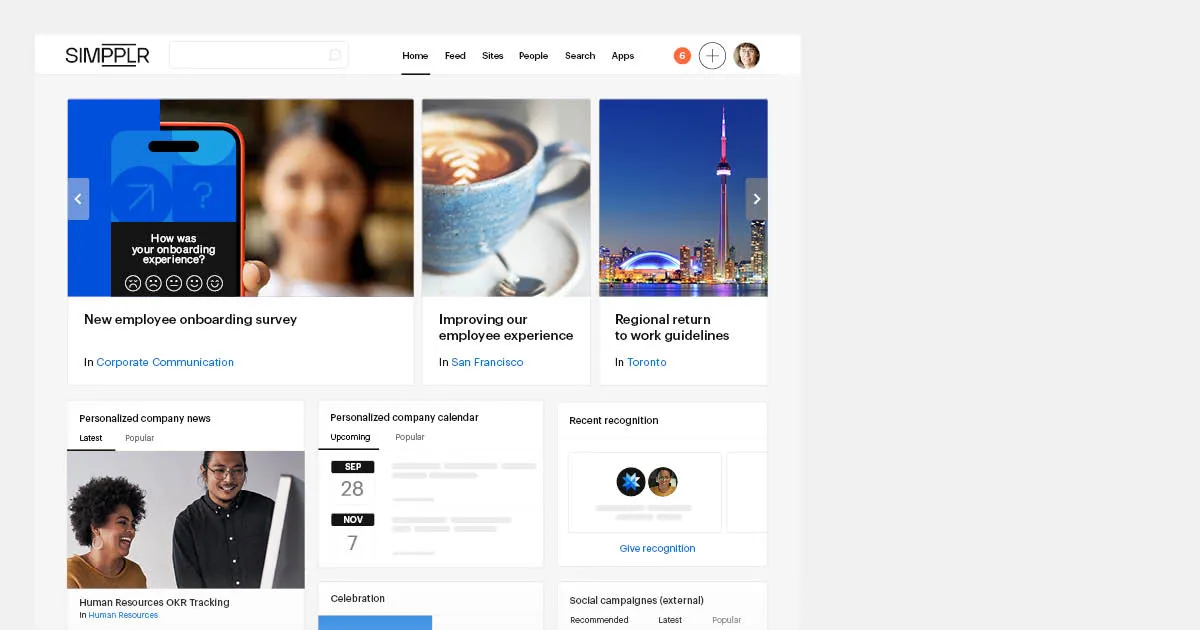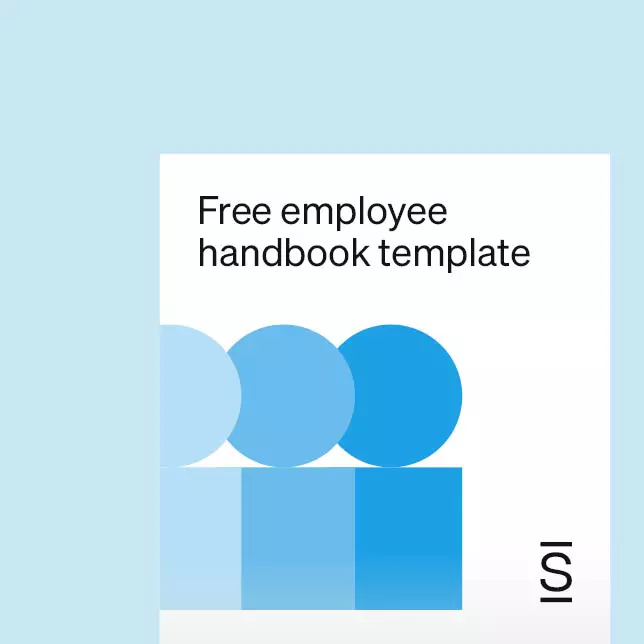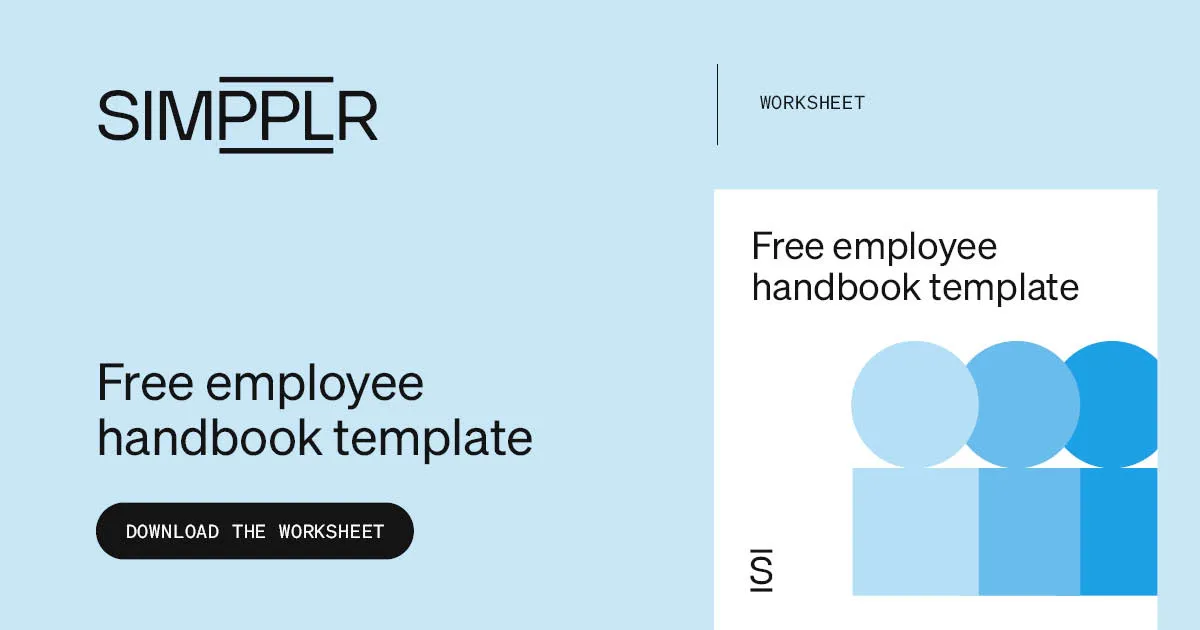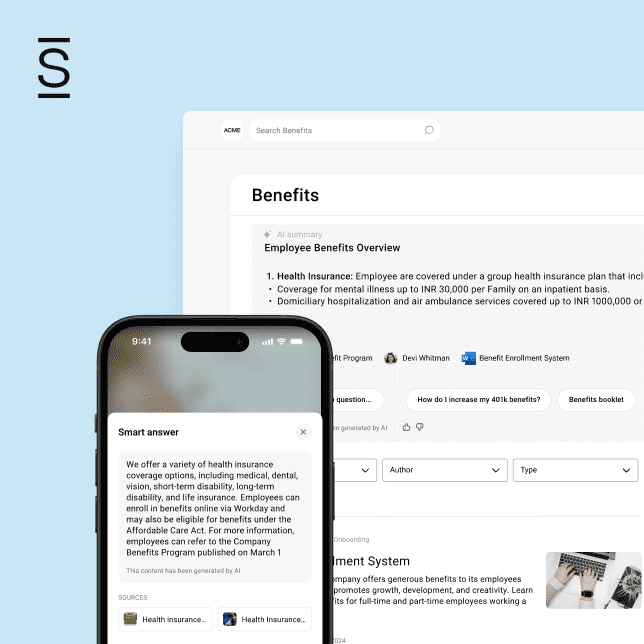Wondering how to create an employee handbook that keeps your workforce aligned and informed, setting the right expectations upfront while helping to protect your organization in case of employment disputes? You’re in the right place.
This comprehensive guide will walk you through how to create an employee handbook that covers all the important bases — from your organization’s history, mission and values to employee benefits and important policies and procedures. And we’ll show you how to make your employee handbook easily accessible — no matter how and where people work. Bonus: Get a free employee handbook template to jumpstart your handbook creation journey!
- 1 Importance of an employee handbook
- 2 Understanding the legal requirements
- 3 Determining the content of your employee handbook
- 4 Aligning your handbook with company culture, mission, vision and values
- 5 Writing clear and concise employee handbook policies
- 6 Structuring the employee handbook
- 7 Reviewing the employee handbook
- 8 Distribution and acknowledgment of the handbook
- 9 Get the free employee handbook template
Importance of an employee handbook

The Society for Human Resources Management (SHRM) emphasizes the importance of a well-crafted employee handbook:
“An employee handbook can be a valuable communication resource for both the employer and the employee. It provides guidance and information related to the organization’s history, mission, values, policies, procedures and benefits in a written format. It is also viewed as a means of protecting the employer against discrimination or unfair treatment claims. It is an easily accessible guide to the company’s policies and practices as well as an overview of the expectations of management.”
An effective employee handbook sets the ground rules and serves as an evolving resource for employees to return to for guidance and support. It reflects the company culture, mission, vision and values that keep it moving forward. It outlines human resources policies and procedures, organizational standards, working conditions and behavioral expectations for employees. For example, many employee handbooks include rules around conduct like discrimination and harassment.
But the best employee handbooks do so much more — they foster a stronger company culture, where employees understand clearly defined policies and expectations that are consistently reinforced.
A compelling employee handbook is a shared foundation, fostering clarity, alignment and connection.
And the clearly written policies within an employee handbook help avoid workplace disruptions that can lead to costly legal actions. “This manual not only keeps employees informed but also serves to protect employers, especially when they ensure that their policies adhere to employment laws,” according to information on Legal Match. “While it may not be legally binding like an employment contract, the handbook is a crucial tool in setting clear expectations and standards within a company.”
A living document
A strong employee handbook and the rules governing corporate HR policies are alive and evolving.
HR managers should never leave these documents on the digital shelf to collect dust.
That means employers must also have a way to revisit policy changes, update their employee handbooks, and disseminate the revised document to their workforce. We cover tips for updating your employee handbook and sharing these changes with employees later in this guide.
Purpose and benefits of creating an employee handbook
Your employee handbook can serve myriad critical functions, including:
- Introduces new employees to the company’s rules, mission and values during onboarding.
- Sets clear expectations for all employees.
- Reduces uncertainty about how to behave on the job.
- Educates employees about job-related tasks, such as recording a timesheet.
- States the legal rights of employees and employers as set by federal and state laws.
- Helps to protect a business against workplace lawsuits such as discrimination, sexual harassment or wrongful termination.
- Provides front-line managers with legal and behavioral guidelines for supervising staff.
- Outlines employee benefits such as parental leave or retirement/401(k).
- Helps to ensure compliance with state and federal laws.
- Shows employees where they can turn to for help, like your employee assistance program (EAP).
- Directs employees to HR-related documents, such as time off requests and nondisclosure agreements.
Not all employee handbooks will include all of this information, and some might contain even more, but this list gives you an idea of the territory you can cover while exploring how to create an employee handbook. For organizations with employees in multiple regions or countries, for example, you can develop region- or country-specific handbooks that address varying laws and policies. Much of the framework and content is the same, except where there are local policies and requirements.
Using your handbook to tell your story
A modern employee handbook incorporates the power of storytelling to share powerful real-life examples of how rules and guidelines affect employees — and why they matter. Especially when you create your employee handbook in a digital format, you can reinforce these rules and guidelines with interactive videos, quizzes and graphics to break up text and make the content more engaging.
A good employee handbook can be essential to your HR strategy by increasing engagement while establishing compliance and policy rules.
Whether you’re creating your first employee handbook or refreshing an existing handbook, think about the work not just as a compliance requirement but as an opportunity to boost employee engagement and connection from day one.
Discover proven strategies to improve employee engagement with a modern intranet
Understanding the legal requirements

To ensure your employee handbook covers the basic legal requirements, check your local and state laws to ensure compliance. Each region or state has its own set of rules, so it can be challenging for HR professionals to stay on top of these regulations, especially with a distributed workforce. However, including relevant local, state and federal laws** within these documents is critical. So, which laws should you consider referencing in your employee handbook?
Some of the U.S. federal laws governing labor issues include:
- Age Discrimination Act: Established to prohibit age discrimination in employees over 40.
- Americans with Disabilities Act: Prevents employment discrimination based on mental or physical disabilities.
- Civil Rights Act: Prohibits color, gender, national origin, race or religious discrimination by employers.
- Equal Pay Act: Seeks to eliminate gender pay differentials.
- Fair Labor Standards Act: Sets federal minimum wage and overtime rules and restricts child labor.
- Family and Medical Leave Act: Requires companies to provide unpaid leave for adoption, childbirth or illness.
- National Labor Relations Act (Wagner Act): Prohibits unfair employer labor practices and gives employees the right to unionize.
- Occupational Safety and Health Act: Protects employee health and safety and establishes rules for a hazard-free workplace.
- Retirement Income Security Act: Establishes standards for private industry retirement and health plans.
- Social Security Act: A financial safety net for elderly, unemployed or disadvantaged Americans.
** This guide provides examples for U.S. employees. Be sure to reference legal requirements for regions/countries outside the U.S. if applicable.
Customizing your employee handbook with local and state laws can be tricky. For example, several “standard” types of U.S. rules went into effect in 2023:
- Illinois passed new paid leave requirements that went into effect January 1, 2024.
- Oregon employees can qualify for up to 14 weeks of paid family, medical and safe leave.
- Louisiana’s medical screening leave policy requires employers in that state to allow paid time off for genetic or preventative cancer screening.
Some U.S. laws also broke new HR ground, such as:
- Arkansas, Tennessee and Texas passed anti-discrimination laws around hair texture or styles associated with race.
- Virginia passed a law requiring time off for organ donation.
Pay transparency laws have gained popularity with job seekers. These rules require employers to provide information on compensation to potential candidates and employees. Approximately eight states and six regions require pay transparency. The effort is designed to close the considerable gender and racial salary inequities in this country.
At the same time, some states and regions have voted to block recruiters from asking about a candidate’s salary history. Nearly two dozen states voted so far to enact these rules.
Second chance hiring laws, also known as fair chance hiring practices, mandate that employers avoid looking at a person’s criminal history until after their interview and pre-qualification. The idea is that these rules give job candidates with a criminal history a chance to compete on their merit.
These rules vary by jurisdiction; existing laws evolve; and new laws take effect — so be sure to get legal advice when creating or updating your employee handbook.
Policy compliance to protect employers
HR legal compliance protects employees and employers from harm, and organizations face penalties and reputational damage if deemed non-compliant.
HR managers must monitor changing rules and know them well.
Employee handbooks can be used as a baseline for policies, standard practices and workflows around these rules. Some best practices include:
- Proactively monitor changes to legal compliance rules.
- Use your employee handbook to establish workplace rules for nondiscrimination, sick leave, work hours, etc.
- Regularly audit and update the handbook.
- Assign dedicated owners of specific policies to help with the audit and monitoring process.
- Attend conferences and webinars and take classes to stay current.
- Train HR teams on employment law.
- Implement workplace rules as laws change.
Embrace the three P’s of employment law compliance: Plan, prevent and protect.
This approach was introduced through a 2010 Department of Labor (DOL) initiative. The three P’s offer a guideline for HR legal compliance, helping employers establish guidelines, proactively monitor changes, and protect their companies against compliance infractions. An employee handbook is critical within this context.
Determining the content of your employee handbook
While every organization’s employee handbook will have its own style, layout, voice and tone, there is some content that employee handbooks generally include:
- Organizational mission, vision and values.
- A disclaimer that the handbook isn’t an employment contract, and that the employee is at-will.
- A notice that the rules within the handbook are subject to change.
- An anti-harassment and equal opportunity statement.
- Family Medical Leave Act (FMLA) policies.
- Workers’ compensation rules (note this varies by state).
- Wages, work classifications and overtime pay under the Fair Labor Standards Act (FLSA).
- Policies on disabilities, employee harassment and workplace safety.
- Insurance and benefits, including paid or unpaid time off.
- General rule of thumb on payroll deductions (varies by work classification, state and even sometimes by the individual) and direct deposit (if applicable).
- Remote work policies (if they are different from on-premise policies).
- Steps to seek help/support, including from a manager, HR or EAP.
- Any other legal requirements specific to your location or type of business.
- An acknowledgment of receipt of the handbook.
Outside this list, there are many other organization-specific nuances, policies and practices you can share in your employee handbook. When creating an employee handbook, one size does not fit all.
Aligning your handbook with company culture, mission, vision and values
One of the greatest values of an employee handbook is its ability to align with your company’s culture, mission, vision and values.
You can use the content to create a cohesive and unified organizational identity.
Start by clearly defining your company’s culture. Is it innovative, collaborative, customer-centric — or something else? How do your mission, vision and values reflect your core culture? Your handbook can reinforce the vibe you want employees to embrace, and you can strengthen these themes with language and tone, graphics and the stories you tell.
For example, if your core value is collaboration, emphasize teamwork in policy guidelines, pictures and visual design, and even in employee testimonials and examples.
Ensure leadership, including executives and managers, endorse the handbook and its alignment with the company’s culture. It can send a powerful message about the importance of the values you outline.
Finally, integrate the company’s culture, mission, vision and values into employee training and onboarding programs. This effort helps new hires understand and embody the organizational ethos from the beginning.
Discover how Nissan used communications to transform culture
Writing clear and concise employee handbook policies
Writing clear and concise employee handbook policies fosters understanding, compliance and a positive workplace culture. Here are some tips to achieve clarity:
- Use plain, straightforward language that a diverse employee base can easily understand.
- Avoid unnecessary jargon, complex terminology and overly legalistic language that might confuse employees.
- Aim for simplicity and brevity while maintaining accuracy.
- Clearly outline expectations and guidelines, ensuring employees can logically follow each policy.
- Use bullet points or numbered lists to break down complex information into easily digestible sections.
- Reinforce policies with examples or practical scenarios to show how they can be applied in your workplace.
Conciseness is equally crucial in crafting effective handbook policies. To write concise policies in your employee handbook:
- Strive to balance covering the necessary information without unnecessary details or excessive elaboration.
- Focus on the key points and essential information employees need to know to fulfill their roles and adhere to company guidelines.
- Trim redundant language and consolidate related policies where possible.
Finally, ensure formatting and style consistency throughout the handbook to enhance its readability.
Structuring the employee handbook

Once you’ve selected what to include, it’s time to look at the structure of your handbook. There are dozens of options, but HR teams must create an organized, logical flow that simplifies even the most highly complex compliance rules.
Use visuals to break up text and make the copy more engaging.
Consider the following outline as a starting point.
1. Introduction
Begin with a warm and welcoming introduction from top leadership, expressing the company’s values, mission and commitment to its employees. Set the handbook’s tone so employees will start to connect with the organization’s vision.
2. Table of contents
Include a comprehensive table of contents for easy navigation. That way, employees can quickly find the information they need without sifting through the entire handbook.
3. Company history, mission, vision and values
Follow the introduction with more detail on the company’s history, mission, vision and values — focus on culture and what employees can expect.
4. Employment relationship
If applicable, clarify the nature of the employment relationship, including employment-at-will status. Outline the expectations for professionalism and behavior.
5. Company policies
This section can include internal behavioral requirements and rules related to legal requirements. You can categorize these sections by:
- Code of conduct: Define expected behavior, ethical standards and workplace etiquette. Outline progressive discipline procedures and establish HR as the go-to resource for new employees.
- Anti-discrimination and harassment: Clearly outline the company’s stance against discrimination and harassment, including reporting procedures.
- Work hours and attendance: Specify working hours, break times, overtime and attendance expectations.
- Leave policies: Address vacation, sick and other types of leave available to employees.
- Performance expectations: Communicate work expectations, including reviews, goals and professional development opportunities.
- Technology and communication: Detail guidelines on using company technology versus employee devices, social media and other communication and collaboration tools.
- Benefits and perks: Provide detailed information about employee benefits, including health insurance, retirement plans and any other perks the company offers. Consider adding policies around disability, personal, military, family medical or bereavement leave.
- Wages and performance: This section could cover when employees are paid or set rules around garnishments or other payroll deductions. It could also cover promotions, transfers or termination. Outline referral bonuses or other financial perks such as end-of-year or profitability bonuses, if applicable.
- Safety and security: Outline workplace safety protocols, emergency procedures and security measures to ensure the well-being of employees.
- Compliance and legal information: Include information on legal requirements, compliance with labor laws, and any industry-specific regulations that employees must be aware of. For example, workers’ compensation or unemployment rules could exist in this section.
6. Acknowledgment and agreement
Include a section where employees acknowledge that they have read and understood the handbook. This documentation can be important in case of any disputes.
7. Appendices
Attach any additional documents or forms relevant to the handbook, such as insurance.
Again, strive for simple language and cut unnecessarily wordy content. Also, try to write the handbook from the new employee’s perspective, asking “What’s in it for me?” Finally, consider that each policy in the handbook has legal implications. Make sure to spell out that these policies are subject to change.
Reviewing the employee handbook
After writing your employee handbook, share it with various stakeholders for review to ensure accuracy, legal compliance and alignment with the company’s values and policies.
Here are key individuals and groups who could review your new employee handbook and what they should evaluate:
- Legal counsel or an employment attorney: Compliance with federal, state and local employment laws and regulations.
- Company leadership: Overall vision and strategic goals of the organization.
- Department managers/employee handbook committee: Department and employee-specific needs and expectations.
- Diversity and inclusion specialists: Inclusive and equitable workplace language.
- Marketing: Clarity, consistency and alignment with the company’s brand and communication style.
- Employee relations: Potential impact of policies on workplace dynamics and a positive employee experience.
- Union representatives (if applicable): Collective bargaining agreements and union requirements.
- Compliance specialists: Industry-specific regulations and standards.
- Quality assurance/editing: Grammatical errors, consistency in formatting, and overall readability.
After incorporating stakeholders’ feedback, consider providing a draft of the handbook to a focus group of employees for a final review before formal distribution. This confidential feedback can help ensure your handbook resonates with its target audience, and identify any areas of confusion or ambiguity.
Tip: Establish review and approval workflows to avoid getting bogged down when making ongoing changes to the employee handbook.
Learn more about the importance of diversity and inclusion in the digital workplace
Distribution and acknowledgment of the handbook

In the past, creating an employee handbook was a laborious process that included printing piles of paper documents for distribution. Fortunately, digital options like a modern intranet streamline the process of sharing employee handbooks and getting employees to formally acknowledge that they’ve read and understand it.
And this is critical. One survey found that 60% of employees avoid reading their employee handbook, and 66% of HR professionals said getting their workforce to read their employee handbook is their top challenge. They cited their second biggest frustration as keeping their employees updated with state compliance rules (62%). Finally, 57% report training managers in handbook enforcement is challenging, partly because these documents change periodically.
An intranet powered by artificial intelligence (AI) can help solve these and other top HR challenges.
Some benefits of leveraging a modern intranet to distribute your employee handbook include:
- The ability to quickly target employee handbook content to specific employees, like new-hires, no matter where they work.
- Features like must-reads and awareness check to verify that employees are reading and absorbing this important content.
- A centralized and easily accessible platform for employees to retrieve the latest real-time version of the handbook.
- AI-driven content moderation to alert you to outdated information then delete or archive it.
- Advanced search capabilities that make it easy for employees to find specific guidelines or policies quickly.
- Cost reductions by avoiding printing and distribution costs.
- The ability to integrate video and interactive features that make the content more engaging and increase knowledge retention.
- Functionality that facilitates two-way communication by allowing employees to provide feedback, ask questions, or seek clarification on policies and procedures.
- Fully customizable and brandable based on user roles or departments, ensuring employees receive information directly relevant to their roles.
- Unlike a physical copy, this handbook can’t be lost, offering robust security features that safeguard sensitive information.
Using the right intranet to distribute your employee handbook is a modern and efficient approach to internal communication.
It empowers you to quickly update and disseminate policies and rules as they change. As a digital transformation strategy for HR communications, modern intranet software is pivotal for enhancing transparency across dispersed teams and creating a more agile and adaptive workplace.
Check out 5 employee onboarding best practices
Get the free employee handbook template
A well-crafted employee handbook can serve as more than a compliance document, laying the groundwork for employee engagement throughout the employment journey. Ready to get started? Be sure to download our free employee handbook template for step-by-step guidance!
Disclaimer: The information in this guide is not intended for legal advice. Please seek legal advice from your legal counsel when creating or updating your employee handbook.


















